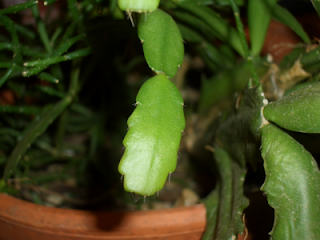Welcome back to another episode of Lost in
the Farmer's Market As you may have noticed due to the holidays and college
assignments there have not been updates in the prior weeks. You need not worry,
the replacement posts are coming shortly starting with this one. Originally I
was planning to talk about food security some more but again due to the number
of papers due for college assignments the food security research has been shelved
for a later date when I’m not buried in assignments. Instead of food security
today’s topic is about a commonly seen house plant that has started to show up
for sale in stores in droves.
So in keeping with the line of discussion
which for this time of the year leans into houseplant territory I would like to
talk about one of the few houseplants that I can honestly say for the longest
time I did not like. Generally around
the holidays the two plants seen the most in stores are Poinsettias and the two
species of holiday cactus. For the purposes of this article I am speaking of
the latter rather then the former. For those who know it by other names
'Holiday' cactus is my generalized term for a group of succulents that are
known for the bloom times which correspond with one of three holidays, Easter,
Christmas or thanksgiving. The three
species are as follows below:
[No picture available]
Rhipsalidopsis
gaetneri - Easter Cactus
 |
| A group of cactus blooms as seen from above in several states of opening. |
 |
| The blooms from a below angle |
 |
| Note the angular parts of the leaf-pads, someone at some point they resembled the bodies of crabs and thus the common name 'Crab Cactus' came about. |
I encountered the Christmas cacti group
around 1999, when I went to work at Van Vleck House and Gardens, which was a
private botanical garden located in Montclair New Jersey. The Horticultural
director there was a guy named Stephan Schuckman. What made it interesting was
that he was a complete and absolute Christmas cacti aficionado, literally there
were hundreds of varieties there at the time in numerous shades, shapes and,
colors. At the time, I had not gained an appreciation for cacti and succulents
at the time and wrote the following in my horticultural notes regarding the Christmas
cacti.
"There is no other plant I know that
is so incredibly boring for about eleven months a year just to get a brief
two-week bloom."
For those of you who don’t know it is
important to note that the holiday cactus is actually succulents, and they come
from South America. This actually makes them
epiphytic or semi-epiphytic as their biology is designed to propagate the
plants with or without seed production. Generally holiday cactus and other
similar species of segmented succulents can self propagate by a process called
shattering. Shattering occurs when the given plant is under extreme stress, and
the response is the separation of the individual pads or leaf segments which
hopefully are moved by animals wind or water to better conditions. Root rot
actually can cause shattering in holiday cactus which can be a method of rescuing
a specimen that has caught a root disease.
What makes the holiday cactus plants so
wide spread as gifts during the holidays is their incredible ease of care.
Their soil should be a basic potting mix with a little extra sand for
drainage. Unlike a lot of true cactus
and some varieties of succulents holiday cacti literally can grow successfully
in the same sorts of potting mixes you would use for a common house plant such
as a Philodendron as long as you mind how often you water. The plants pictured
in this article are generally watered perhaps once every two weeks and even
then not enough that there is runoff. Additionally unlike a number of house
plants Christmas cacti benefit from being outside for as long as the
temperatures permit as the natural light aids in bud formation. Much like poinsettias
and chrysanthemums holiday cactus's flower formation is relative to the length
and intensity of daylight, as the shortening of day length prompts these plants
to bloom.
The irony is now; there is always at least
one holiday cactus in my collection as I've come to appreciate the key aspects
of the plant. It spends most of the year
sandwiched between the Rhipsalis out on the deck, but as the photos show when
it is blooming it becomes a table decoration to brighten up the holidays. In
that light, it is also quite amazing how your mind can change with time and
experience, to that end I suggest you try a holiday cactus as far as easy house
plants go I would say this one if pretty easy and they make a nice colorful
gift.
I have to say this post replaced the
original planned post about food security for several reasons, most of which
pertain to research issues and college workload. Don’t worry the food security
stuff will be back as soon as I get a moment to really dig into the information
and verify the facts around it. My next
post will cover a relative of Holiday cactus, the Rhipsalis genus. For note
both schlumbergia and rhipsalis belong to the Rhipsalideae 'tribe' so they are distinctly
related, but it is not clear until they bloom.
Happy thanks giving and as always folks
Keep 'em growing!

No comments:
Post a Comment